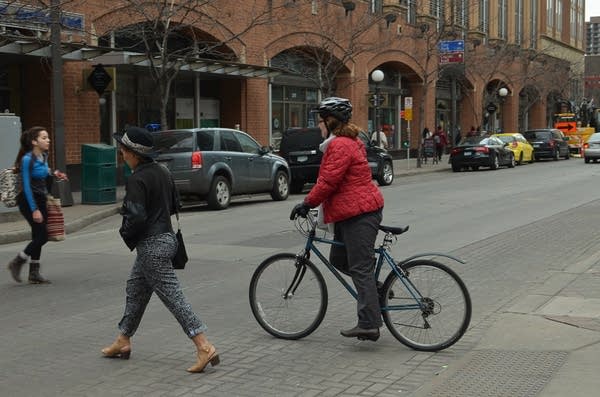Car balk? Report reveals many in Twin Cities walk, bike to work

Go Deeper.
Create an account or log in to save stories.
Like this?
Thanks for liking this story! We have added it to a list of your favorite stories.
Far more Twin Cities residents are bicycling or walking to work than U.S. Census numbers reported, according to a new detailed analysis of transportation habits.
The University of Minnesota study set to be released later this month calculates the number of people getting to work on foot or bike is two to three times larger than Census estimates.
The study found 414,000 people in the expanded 19-county metropolitan area made about 1.3 million non-motorized trips on a typical weekday. Biking and walking accounted for almost 9 percent of all trips in the region, according to the overall data.
The research is based on in-depth travel diaries that are collected each decade by the Metropolitan Council. Researchers said the travel diaries more accurately capture the range of ways that people get around each day than other studies.
Turn Up Your Support
MPR News helps you turn down the noise and build shared understanding. Turn up your support for this public resource and keep trusted journalism accessible to all.
The new non-motorized trip numbers are often double the size of estimates from other data sources like the U.S. Census and the yearly American Community Survey, said Jessica Schoner, a Ph.D. candidate in transportation engineering at the University of Minnesota and lead author on the study.

"This data is new and novel," Schoner said. "It's a travel diary format, so it's capturing every trip people make throughout the day."
U.S. Census numbers in Minneapolis, for instance, put the proportion of commuters on bikes at just 4.1 percent, while the travel diaries put it at 9.2 percent. That's partly because the Census doesn't capture people who are part-time bicyclists.
"If you drove to work three times and week and biked two times a week, then you're counted as a driver in that," Schoner said.
The new data could have implications for policy discussions about building more transportation infrastructure dedicated to biking and walking, said Minneapolis bicycle and pedestrian coordinator Matthew Dyrdahl.
"Developing this standard way to count will be really helpful for people like me in public works to make more informed decisions based on how people are actually using the system, and for policy makers," Dyrdahl said.
Comparing data from the travel diaries collected a decade apart also shows an overall increase in the amount of non-motorized transportation in the region between 2001 and 2011.
Researchers found that the number of trips taken by bike in the metropolitan area increased by about 58 percent. Across the metro area, walking also saw a 44 percent increase.
The increase was even more stark in the core cities, with the proportion of bike trips in Minneapolis rising from 3.9 percent of all trips taken to 6 percent. St. Paul saw the number of bike trips almost double.
Although the study's most recent data was collected in 2011, the report's authors said other available data like city bike counts appears to confirm that the rates of bicyclists and walkers in the region continues to rise.
Bicycling mode share in Minneapolis is nearly triple that in St. Paul, and four to five times higher than rates in suburban and ring counties, according to the research.
Minneapolis' recent investments in bicycling and walking infrastructure, such as trails and bike boulevards, may be one reason that rates in the city appear to have been increasing at such a rate, said David Levinson, a University of Minnesota professor of transportation and principal investigator of the study.
"If you want to attract people who want to bicycle, putting the facilities in will attract them," Levinson said. "People who know they want to bicycle are more likely to live in Minneapolis than to move to the suburbs."
Although women who bicycle took as many trips as men who bicycle, the proportion of women who bicycle even in Minneapolis is about one-and-a-half times smaller than men. Even though Minneapolis leads the region in bicycle-friendly development, Levinson said the gender gap may be due to the fact that the infrastructure still isn't developed to the point where many people feel safe bicycling.
"Right now we allocate road space for moving cars, we allocate road space for storing cars, but very few places are reallocating road space for moving bicycles," Levinson said. "Is moving bicycles more important than storing cars?
Both core cities have recently pushed forward extensive plans to develop more bicycle and pedestrian infrastructure.
Minneapolis announced a plan earlier this spring to add 35 miles of protected bikeways in the city by 2020, which could mean anything from off-street trails to bike lanes protected by a raised curb.

"The new wave of the bicycle and pedestrian planning is to make the healthy choice the easy choice," Dyrdahl said. "Making it easy to get to the grocery store, making it easy to get to work is important as opposed to only focusing on long-distance recreational trails."
The St. Paul City Council has approved an extensive bike plan for the city, although there is no timeline to implement it and the city has yet to identify a funding source for the full plan.
The University of Minnesota study is the second of a five-part series on transportation by the research team sponsored by the Minnesota Department of Transportation and the Metropolitan Council.


